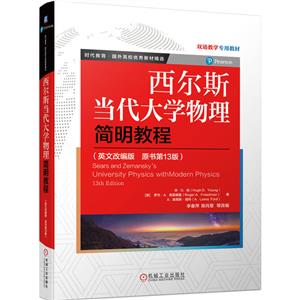-
>
闖進(jìn)數(shù)學(xué)世界――探秘歷史名題
-
>
中醫(yī)基礎(chǔ)理論
-
>
當(dāng)代中國(guó)政府與政治(新編21世紀(jì)公共管理系列教材)
-
>
高校軍事課教程
-
>
思想道德與法治(2021年版)
-
>
毛澤東思想和中國(guó)特色社會(huì)主義理論體系概論(2021年版)
-
>
中醫(yī)內(nèi)科學(xué)·全國(guó)中醫(yī)藥行業(yè)高等教育“十四五”規(guī)劃教材
西爾斯當(dāng)代大學(xué)物理簡(jiǎn)明教程(英文改編版 原書(shū)第13版) 版權(quán)信息
- ISBN:9787111697121
- 條形碼:9787111697121 ; 978-7-111-69712-1
- 裝幀:平裝-膠訂
- 冊(cè)數(shù):暫無(wú)
- 重量:暫無(wú)
- 所屬分類:>
西爾斯當(dāng)代大學(xué)物理簡(jiǎn)明教程(英文改編版 原書(shū)第13版) 本書(shū)特色
《西爾斯當(dāng)代大學(xué)物理》原書(shū)第13版,參照教育部高等學(xué)校物理基礎(chǔ)課程教學(xué)指導(dǎo)分委員會(huì)制定的《理工科類大學(xué)物理課程教學(xué)基本要求》(2010年版),依據(jù)我國(guó)大學(xué)生的學(xué)習(xí)基礎(chǔ)和教學(xué)大綱的知識(shí)點(diǎn)要求改編。
西爾斯當(dāng)代大學(xué)物理簡(jiǎn)明教程(英文改編版 原書(shū)第13版) 內(nèi)容簡(jiǎn)介
本書(shū)基于SEARS AND ZEMANSKY’S UNIVERSITY PHYSICS WITH MODERN PHYSICS,13E(《西爾斯當(dāng)代大學(xué)物理》原書(shū)第13版),參照教育部高等學(xué)校物理基礎(chǔ)課程教學(xué)指導(dǎo)分委員會(huì)制定的《理工科類大學(xué)物理課程教學(xué)基本要求》(2010年版),依據(jù)我國(guó)大學(xué)生的學(xué)習(xí)基礎(chǔ)和教學(xué)大綱的知識(shí)點(diǎn)要求改編。本書(shū)涵蓋了上述教學(xué)基本要求中的所有A類知識(shí)點(diǎn),主要內(nèi)容有力學(xué)、熱學(xué)、電磁學(xué)、波動(dòng)光學(xué)、相對(duì)論和量子物理。本書(shū)的特點(diǎn)是,在改編過(guò)程中對(duì)內(nèi)容和習(xí)題進(jìn)行了精選,不僅接近繼承了原書(shū)的特色,還在行文上接近保留了原版教材原汁原味的表述,其內(nèi)容和閱讀量更適合中國(guó)理工科類相關(guān)專業(yè)作為雙語(yǔ)教學(xué)的教材,同時(shí)可供社會(huì)讀者閱讀。
西爾斯當(dāng)代大學(xué)物理簡(jiǎn)明教程(英文改編版 原書(shū)第13版) 目錄
1 VECTORS1
1.1 Vectors and Vector Addition1
1.2 Components of Vectors3
1.3 Unit Vectors4
1.4 Products of Vectors5
SUMMARY7
EXERCISES8
2 MOTION9
2.1 Position and Velocity Vectors9
2.2 The Acceleration Vector12
2.3 Motion with Constant Acceleration14
2.4 Velocity and Position by Integration16
2.5 Projectile Motion and Motion in a Circle18
2.6 Relative Velocity21
SUMMARY24
EXERCISES26
3 NEWTON’S LAWS OF MOTION27
3.1 Force and Interactions27
3.2 Newton’s Law28
3.3 Mass and Weight30
3.4 Free-Body Diagrams32
SUMMARY33
EXERCISES34
4 APPLYING NEWTON’S LAWS35
4.1 Using Newton’s Laws35
4.2 Dynamics of Circular Motion39
4.3 The Fundamental Forces of Nature41
SUMMARY43
EXERCISES44
5 WORK AND KINETIC ENERGY45
5.1 Work45
5.2 Work and Energy with Varying Forces48
5.3 Power52
SUMMARY54
EXERCISES55
6 POTENTIAL ENERGY AND ENERGY
CONSERVATION57
6.1 Gravitational Potential Energy 57
6.2 Elastic Potential Energy62
6.3 Conservative and Nonconservative Forces64
6.4 Force and Potential Energy66
6.5 Energy Diagrams69
6.6 The Motion of Satellites70
SUMMARY73
EXERCISES75
7 MOMENTUM, IMPULSE, AND
COLLISIONS77
7.1 Momentum and Impulse77
7.2 Conservation of Momentum81
7.3 Momentum Conservation and Collisions83
7.4 Elastic Collisions87
7.5 Center of Mass89
7.6 Rocket Propulsion93
SUMMARY95
EXERCISES97
8 ROTATION OF RIGID BODIES99
8.1 Angular Velocity and Acceleration99
8.2 Relating Linear and Angular Kinematics103
8.3 Energy in Rotational Motion106
8.4 Parallel-Axis Theorem111
8.5 Moment-of-Inertia Calculations112
SUMMARY114
EXERCISES115
9 DYNAMICS OF ROTATIONAL
MOTION117
9.1 Torque117
9.2 Torque and Angular Acceleration for a
Rigid Body119
9.3 Work and Power in Rotational Motion122
9.4 Angular Momentum124
9.5 Conservation of Angular Momentum127
9.6 Gyroscopes and Precession130
SUMMARY133
EXERCISES134
10 PERIODIC MOTION137
10.1 Describing Oscillation137
10.2 Simple Harmonic Motion139
10.3 Energy in Simple Harmonic Motion146
10.4 Vertical SHM148
10.5 The Simple Pendulum150
10.6 The Physical Pendulum151
10.7 Damped Oscillations152
10.8 Forced Oscillations and Resonance153
SUMMARY155
EXERCISES156
11 MECHANICAL WAVES159
11.1 Types of Mechanical Waves159
11.2 Periodic Waves160
11.3 Mathematical Description of a Wave163
11.4 Speed of a Transverse Wave168
11.5 Energy in Wave Motion169
11.6 Wave Interference, Boundary Conditions, and Superposition171
11.7 Standing Waves on a String174
11.8 Normal Modes of a String178
11.9 Sound Wates and Sound Intensity180
11.10 The Doppler Effect181
11.11 Shock Waves184
SUMMARY185
EXERCISES187
12 TEMPERATURE, HEAT AND THERMAL
PROPERTIES OF MATTER189
12.1 Temperature and Thermal Equilibrium189
12.2 Thermometers and Temperature Scales190
12.3 Gas Thermometers and the Kelvin Scale190
12.4 Quantity of Heat190
12.5 Equations of State192
12.6 Molecular Properties of Matter193
12.7 Kinetic-Molecular Model of an Ideal Gas194
12.8 Heat Capacities199
12.9 Molecular Speeds201
SUMMARY203
EXERCISES204
13 THE FIRST LAW OF THERMODY
NAMICS207
13.1 Thermodynamic Systems207
13.2 Work Done During Volume Changes208
13.3 Paths Between Thermodynamic States209
13.4 Internal Energy and the First Law
of Thermodynamics210
13.5 Kinds of Thermodynamic Processes214
13.6 Internal Energy of an Ideal Gas215
13.7 Heat Capacities of an Ideal Gas216
13.8 Adiabatic Processes for an Ideal Gas219
SUMMARY221
EXERCISES222
14 THE SECOND LAW OF
THERMODYNAMICS225
14.1 Directions of Thermodynamic Processes225
14.2 Heat Engines226
14.3 Internal-Combustion Engines228
14.4 Refrigerators230
14.5 The Second Law of Thermodynamics232
14.6 The Carnot Cycle233
14.7 Entropy236
14.8 Microscopic Interpretation of Entropy240
SUMMARY241
EXERCISES243
15 ELECTRIC CHARGE AND ELECTRIC
FIELD245
15.1 Electric Charge245
15.2 Conductors, Insulators, and
Induced Charges246
15.3 Coulomb’s Law247
15.4 Electric Field and Calculations248
15.5 Electric Field Lines254
15.6 Electric Dipoles255
SUMMARY256
EXERCISES257
西爾斯當(dāng)代大學(xué)物理簡(jiǎn)明教程(英文改編版 原書(shū)第13版) 作者簡(jiǎn)介
休 · D.楊 羅杰 · A.弗里德曼 A.路易斯 · 福特
- >
月亮虎
- >
山海經(jīng)
- >
李白與唐代文化
- >
自卑與超越
- >
伊索寓言-世界文學(xué)名著典藏-全譯本
- >
中國(guó)人在烏蘇里邊疆區(qū):歷史與人類學(xué)概述
- >
【精裝繪本】畫(huà)給孩子的中國(guó)神話
- >
煙與鏡
















